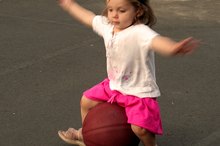Locations of Reflex Points on the Body
When a doctor tests your reflexes, she looks not only for movement of the stimulated muscle but also for speed and briskness of reaction. Slow or diminished reflexes can indicate a localized problem or a remote disease affecting neural function, likely near the spine. Abnormal reflex response ranges from absent or subtle, known as hyporeflexia, to overly brisk or repeating, known as hyperreflexia. With a partner, you can gauge your own reflex responses.
Achilles
To test this reflex, lie belly down, or kneel on a chair, with your ankles extended beyond the bed or chair. The toes should point down, ankles facing the ceiling. Have a partner push your toes into flexion as he taps the achilles tendon with a hammer or sharply with a finger. In a normal reflex, the foot either kicks back or forward. The tester should then tap on either side of the tendon to gauge briskness of the reflex.
- To test this reflex, lie belly down, or kneel on a chair, with your ankles extended beyond the bed or chair.
Knee
How to Tell If You Have Fluid on the Knee
Learn More
Many a schoolchild has tested the patellar reflex on her friends. Accurate placement of the percussion hammer is at the soft spot between the bottom of the knee cap and the top of the tibia. A healthy reflex looks like a kick and indicates proper functioning of the spinal cord, the nerves that run along it and the motor cortex of the brain. Diminished, subtle or absent reflex at the knee, known as the Erb-Westphal sign, could mean there is a problem near the vertebrae, such as a herniated disc or peripheral nerve disease.
- Many a schoolchild has tested the patellar reflex on her friends.
- A healthy reflex looks like a kick and indicates proper functioning of the spinal cord, the nerves that run along it and the motor cortex of the brain.
Forearm
The forearm reflex is known as the radial nerve reflex, or the extensor digitorum reflex, named after the muscle that runs from the elbow down the forearm to the wrist. Healthy reflex response is an indicator of normal neurologial function. A latent, or abnormal, reflex could indicate pathology of the radial nerve. To test this reflex, have a partner relax or partly flex their hands, then tap the thumb-side of forearm muscle a few inches above the wrist. In a healthy response, your partner's fingers will suddenly extend.
- The forearm reflex is known as the radial nerve reflex, or the extensor digitorum reflex, named after the muscle that runs from the elbow down the forearm to the wrist.
- To test this reflex, have a partner relax or partly flex their hands, then tap the thumb-side of forearm muscle a few inches above the wrist.
Upper Arm
Rehabilitation Exercises for a Dislocated Finger
Learn More
The biceps reflex tests function of the nerves of the upper arm and the C5 and C6 vertebrae of the cervical spine. To test it on a partner, have him sit with a relaxed arm. The arm should be slightly bent at the elbow. Find the place where the biceps muscle connects to the inner elbow. Using your thumb, place light pressure on the bicep and strike your own thumb with a reflex hammer. Proper functioning of the reflex causes a bicep curling motion that bends the elbow joint.
- The biceps reflex tests function of the nerves of the upper arm and the C5 and C6 vertebrae of the cervical spine.
- Using your thumb, place light pressure on the bicep and strike your own thumb with a reflex hammer.
Related Articles
References
- NCBI; Deep Tendon Reflexes; H. Kenneth Walker; 1990
- YouTube; Achilles Reflex; September 2008
- NCBI; Applying the extensor digitorum reflex to neurological examination; Zhang MJ, Zhu CZ, Duan ZM, Niu X.; October 2010
- Sanders RD, Gillig PM. Reflexes in psychiatry. Innovations in clinical neuroscience. 2011;8(4):24-9.
- Walker HK. The suck, snout, palmomental, and grasp reflexes. In: Walker HK, Hall WD, Hurst JW, eds. Clinical Methods: The History, Physical, and Laboratory Examinations. 3rd edition. Boston: Butterworths; 1990. Chapter 71.
- Glaser JA, Curé JK, Bailey KL, Morrow DL. Cervical spinal cord compression and the Hoffmann sign. The Iowa Orthopaedic Journal. 2001;21:49-52.
- Sanders RD, Gillig PM. Reflexes in psychiatry. Innovations in clinical neuroscience. 2011;8(4):24-9.
- Acharya AB, Jamil RT, Dewey JJ. Babinski reflex. StatPearls. Updated July 31, 2020.
- Walker HK. The suck, snout, palmomental, and grasp reflexes. In: Walker HK, Hall WD, Hurst JW, eds. Clinical Methods: The History, Physical, and Laboratory Examinations. 3rd edition. Boston: Butterworths; 1990. Chapter 71.
- Hamedani AG, Gold DR. Eyelid dysfunction in neurodegenerative, neurogenetic, and neurometabolic disease. Front Neurol. 2017;8. doi:10.3389/fneur.2017.00329
- Gabelle A, Gutierrez LA, Dartigues JF, Ritchie K, Touchon J, Berr C. Palmomental reflex a relevant sign in early Alzheimer's disease diagnosis? Journal of Alzheimer's disease : JAD. 2016;49(4):1135-41. doi:10.3233/JAD-150436
- Reeves A., Swenson, R. Reflex evaluation. 5th ed. Disorders of the nervous system: A primer. Hanover, NH: Dartmouth College. 2008.
- Mellick LB, Al-Dhahir MA. Cremasteric reflex. StatPearls. Updated July 3, 2020.
- Zimmerman B, Hubbard JB. Clonus. StatPearls. Updated August 13, 2020.
- Glaser JA, Curé JK, Bailey KL, Morrow DL. Cervical spinal cord compression and the Hoffmann sign. The Iowa Orthopaedic Journal. 2001;21:49-52.
Resources
Writer Bio
Leigha Butler is co-owner of The Yoga House in Kingston, N.Y., where she teaches Vinyasa and Ashtanga-based yoga classes and workshops. Her teaching emphasizes anatomical alignment, individual modifications and hands-on adjustments. She is also a lecturer in college English, specializing in literature of the environment. Butler holds a Master of Arts in English from University of Nevada, Reno.








